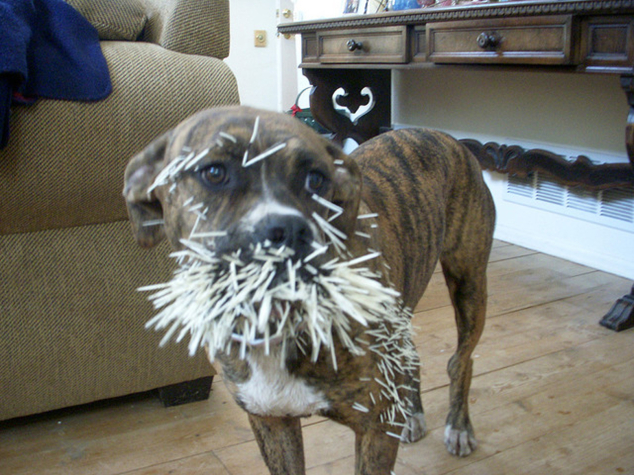
My friend Eva had a wildlife encounter in our Andover yard recently. Some motion in a nearby tree caught her eye, and when she looked she thought she might be seeing a monkey. Walking and looking a little closer helped Eva realize that she was looking up at a porcupine.
If you have been close to a porcupine you know what a strange sight it is: a rather cute face crowned by an upswept coiffure, followed by a scary array of quills toward the rear. If the porcupine is alarmed by your presence, those quills stand up in a menacing way.
Porcupines (the name means “quill pig”) are rodents with large front teeth and an appetite for woody things, which is why they are usually seen in trees. They eat bark, stems, leaves, buds, and sometimes the back porch steps. But it is the quills you are thinking about if you suddenly find yourself close to a porcupine.
Wait a minute! Is it true that they can shoot those quills? How far?
The answer is no — porcupines cannot shoot their quills, but the quills do detach easily when touched, as many dog owners know. The quills have sharp tips and barbs that overlap, making them difficult to remove.
While a veterinarian is removing a muzzle-full of quills from a dog, the porcupine has already begun growing new quills to replace them. The myth about porcupines firing off their quills raises the question about other myths we have about plants and animals.
What about toads and warts – can touching a toad give you warts? Again, the answer is no.
A human virus causes warts, not the skin of a toad, but the myth is probably rooted in experience. Some toads have bumps that look like warts and contain parotid glands which produce a poison that can be irritating. If you do pick up a toad, be prepared for its other line of defense – a gift of dark brown urine.
Many people believe that daddy longlegs are poisonous spiders whose fangs are too weak to bite you. Wrong, wrong, and wrong again. They aren’t spiders, and they aren’t venomous, and they don’t have fangs. Yes, they are arachnids, but that class includes many orders; daddy longlegs are one of over 6,000 species in the Opiliones order.
Naughty or curious children have been known to pull off one leg of a daddy longleg, based on a belief that it will grow back. That’s not true, so don’t do it.
Have some respect for these ancient creatures. A perfect fossil of a daddy longlegs found in Scotland proved to be at least 400 million years old — that particular daddy longlegs was walking on Earth 200 million years before the first dinosaur showed up.
And is a poison ivy rash contagious? No, it’s not. As long as you wash your body, you can’t pass along the rash to another person. It is true that you can get a rash from poison ivy oil that is still on clothing or shoes, so it is important to wash everything completely.
We all know that birds will abandon their eggs and young if humans touch them. Wrong again. This myth depends on the belief that birds can detect human scent, but birds have such small and simple olfactory nerves that their sense of smell is limited. Biologists point out that birds will abandon their young based on repeated disturbances, so while one visit to a nest is probably fine, you should then leave the nest alone.
What if you see a nestling or fledging baby bird on your lawn? Should you pick it up? According to the Cornell Lab of Ornithology, you should make sure your pets are inside and then watch the baby bird from a distance. Usually the parents have been watching the whole time and will return and continue their feeding and care.
If no parent returns within a couple of hours, there is a problem. Consult the Cornell Lab Web site at Birds.Cornell.edu for helpful suggestions on what to do next.
Here’s a final myth that concerns humans: if you are engaged in some outside activity like hiking, kayaking, trail running, bird watching, hunting, or fishing and experience an emergency that requires a search and rescue mission, at least you won’t have to pay for that service. Not true.
As of 1999, the New Hampshire Fish and Game Department (NHF&G) reviews each mission to determine whether a bill should be sent to those involved. Persons whose negligence causes them to be lost or injured may have to pay. For example, a hiker who is poorly equipped for the terrain or the weather is considered negligent.
According to NHF&G, “A law that took effect in January 2015 authorizes the NHF&G to sell a voluntary hike-safe card for $25 per person and $35 per family. People who obtain the cards will not be liable to repay rescue costs if they need to be rescued due to negligence on their part…. An individual may still be liable for response expenses, however, if such person is deemed to have recklessly or intentionally created a situation requiring an emergency response.
“People who possess a current NHF&G hunting or fishing license or a current registration for an off-highway recreational vehicle, snowmobile, or boat will also be exempt from repaying rescue costs due to negligence.” The card is available for purchase at Wildlife.State.NH.us/safe.